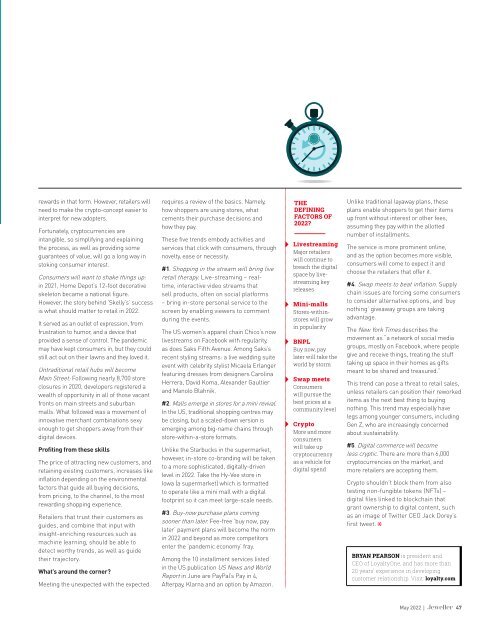Jeweller - May 2022
A new era: The pearl industry has been strengthened by adversity Responsibly sourced: Retailers want to provide it, but what does it really mean? Crystal ball: In order to predict trends, we learn from the past
A new era: The pearl industry has been strengthened by adversity
Responsibly sourced: Retailers want to provide it, but what does it really mean?
Crystal ball: In order to predict trends, we learn from the past
Create successful ePaper yourself
Turn your PDF publications into a flip-book with our unique Google optimized e-Paper software.
ewards in that form. However, retailers will<br />
need to make the crypto-concept easier to<br />
interpret for new adopters.<br />
Fortunately, cryptocurrencies are<br />
intangible, so simplifying and explaining<br />
the process, as well as providing some<br />
guarantees of value, will go a long way in<br />
stoking consumer interest.<br />
Consumers will want to shake things up:<br />
in 2021, Home Depot’s 12-foot decorative<br />
skeleton became a national figure.<br />
However, the story behind ‘Skelly’s’ success<br />
is what should matter to retail in <strong>2022</strong>.<br />
It served as an outlet of expression, from<br />
frustration to humor, and a device that<br />
provided a sense of control. The pandemic<br />
may have kept consumers in, but they could<br />
still act out on their lawns and they loved it.<br />
Untraditional retail hubs will become<br />
Main Street: Following nearly 8,700 store<br />
closures in 2020, developers registered a<br />
wealth of opportunity in all of those vacant<br />
fronts on main streets and suburban<br />
malls. What followed was a movement of<br />
innovative merchant combinations sexy<br />
enough to get shoppers away from their<br />
digital devices.<br />
Profiting from these skills<br />
The price of attracting new customers, and<br />
retaining existing customers, increases like<br />
inflation depending on the environmental<br />
factors that guide all buying decisions,<br />
from pricing, to the channel, to the most<br />
rewarding shopping experience.<br />
Retailers that trust their customers as<br />
guides, and combine that input with<br />
insight-enriching resources such as<br />
machine learning, should be able to<br />
detect worthy trends, as well as guide<br />
their trajectory.<br />
What’s around the corner?<br />
Meeting the unexpected with the expected<br />
requires a review of the basics. Namely,<br />
how shoppers are using stores, what<br />
cements their purchase decisions and<br />
how they pay.<br />
These five trends embody activities and<br />
services that click with consumers, through<br />
novelty, ease or necessity.<br />
#1. Shopping in the stream will bring live<br />
retail therapy. Live-streaming – realtime,<br />
interactive video streams that<br />
sell products, often on social platforms<br />
– bring in-store personal service to the<br />
screen by enabling viewers to comment<br />
during the events.<br />
The US women’s apparel chain Chico’s now<br />
livestreams on Facebook with regularity,<br />
as does Saks Fifth Avenue. Among Saks’s<br />
recent styling streams: a live wedding suite<br />
event with celebrity stylist Micaela Erlanger<br />
featuring dresses from designers Carolina<br />
Herrera, David Koma, Alexander Gaultier<br />
and Manolo Blahnik.<br />
#2. Malls emerge in stores for a mini revival.<br />
In the US, traditional shopping centres may<br />
be closing, but a scaled-down version is<br />
emerging among big-name chains through<br />
store-within-a-store formats.<br />
Unlike the Starbucks in the supermarket,<br />
however, in-store co-branding will be taken<br />
to a more sophisticated, digitally-driven<br />
level in <strong>2022</strong>. Take the Hy-Vee store in<br />
Iowa (a supermarket) which is formatted<br />
to operate like a mini mall with a digital<br />
footprint so it can meet large-scale needs.<br />
#3. Buy-now purchase plans coming<br />
sooner than later. Fee-free ‘buy now, pay<br />
later’ payment plans will become the norm<br />
in <strong>2022</strong> and beyond as more competitors<br />
enter the ‘pandemic economy’ fray.<br />
Among the 10 installment services listed<br />
in the US publication US News and World<br />
Report in June are PayPal’s Pay in 4,<br />
Afterpay, Klarna and an option by Amazon.<br />
THE<br />
DEFINING<br />
FACTORS OF<br />
<strong>2022</strong>?<br />
Livestreaming<br />
Major retailers<br />
will continue to<br />
breach the digital<br />
space by livestreaming<br />
key<br />
releases<br />
Mini-malls<br />
Stores-withinstores<br />
will grow<br />
in popularity<br />
BNPL<br />
Buy now, pay<br />
later will take the<br />
world by storm<br />
Swap meets<br />
Consumers<br />
will pursue the<br />
best prices at a<br />
community level<br />
Crypto<br />
More and more<br />
consumers<br />
will take up<br />
cryptocurrency<br />
as a vehicle for<br />
digital spend<br />
Unlike traditional layaway plans, these<br />
plans enable shoppers to get their items<br />
up front without interest or other fees,<br />
assuming they pay within the allotted<br />
number of installments.<br />
The service is more prominent online,<br />
and as the option becomes more visible,<br />
consumers will come to expect it and<br />
choose the retailers that offer it.<br />
#4. Swap meets to beat inflation. Supply<br />
chain issues are forcing some consumers<br />
to consider alternative options, and ‘buy<br />
nothing’ giveaway groups are taking<br />
advantage.<br />
The New York Times describes the<br />
movement as “a network of social media<br />
groups, mostly on Facebook, where people<br />
give and receive things, treating the stuff<br />
taking up space in their homes as gifts<br />
meant to be shared and treasured.”<br />
This trend can pose a threat to retail sales,<br />
unless retailers can position their reworked<br />
items as the next best thing to buying<br />
nothing. This trend may especially have<br />
legs among younger consumers, including<br />
Gen Z, who are increasingly concerned<br />
about sustainability.<br />
#5. Digital commerce will become<br />
less cryptic. There are more than 6,000<br />
cryptocurrencies on the market, and<br />
more retailers are accepting them.<br />
Crypto shouldn’t block them from also<br />
testing non-fungible tokens (NFTs) –<br />
digital files linked to blockchain that<br />
grant ownership to digital content, such<br />
as an image of Twitter CEO Jack Dorey’s<br />
first tweet.<br />
BRYAN PEARSON is president and<br />
CEO of LoyaltyOne, and has more than<br />
20 years' experience in developing<br />
customer relationship. Visit: loyalty.com<br />
<strong>May</strong> <strong>2022</strong> | 47


















